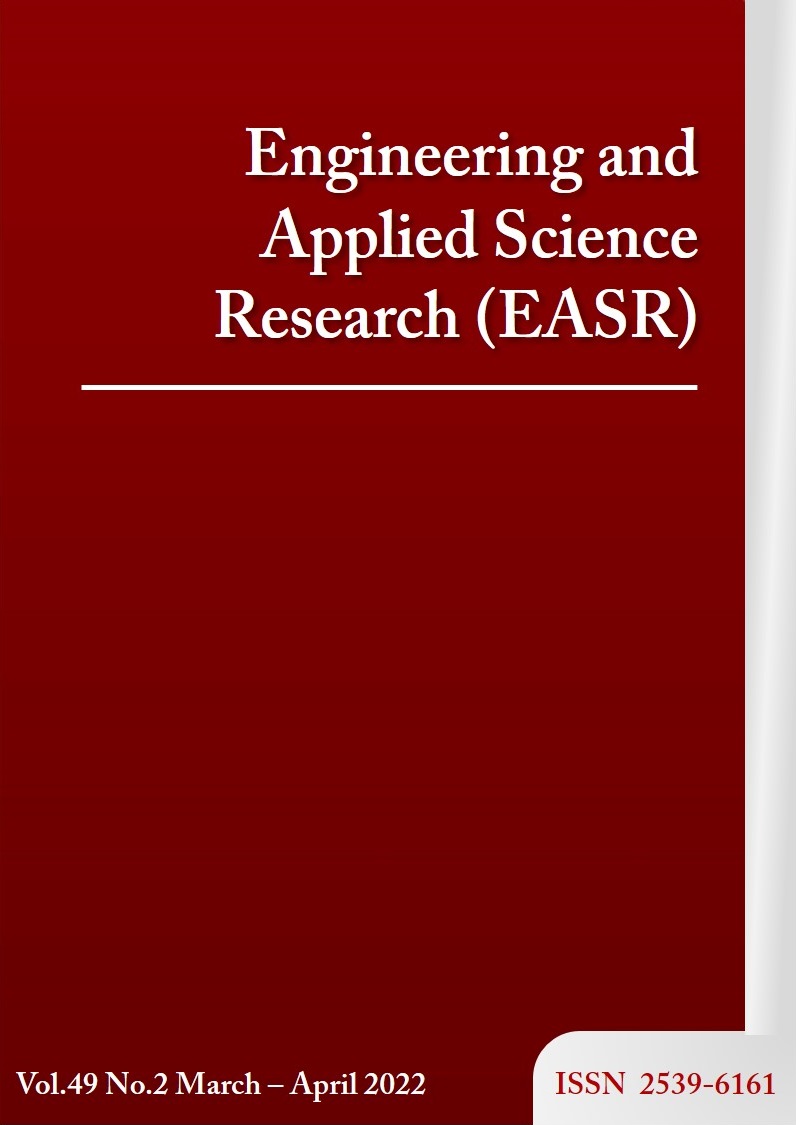Multi-objective optimization of a threading machine for tobacco leaves
Main Article Content
Abstract
The threading of Turkish or Oriental tobacco leaves is part of the sun drying process prior to cigarette production. In Thailand, tobacco leaves tend to be threaded manually by farmers, resulting in low production capacity due to insufficient labor being available. Therefore, the aim of this research is to analyze the tangential velocity of conveyor trays and the number of tobacco leaves pressed into needles, thereby affecting the working capacity of the machine. The machine comprises three main units. A programmable logic controller (PLC) is applied to control the machine’s operation. The factors under study include the tangential velocity of conveyor trays (0.13, 0.15, and 0.18 m/s) and the number of tobacco leaves pressed into needles using either seven or eight trays each time. The results of multiple-objective optimization for the tobacco threading machine are analyzed using the weighted sum method, revealing a tray tangential velocity of 0.15 m/s, while the use of eight trays per time produces the maximum capacity of 3,887 leaves per hour. In addition, analysis of the percentage minimum leaves lost indicates that the tangential velocity of the trays is 0.13 m/s, while pressing prior to gathering seven trays per time prevents 0.91 and 0.61% of the leaves from falling and tearing, respectively, during the threading process. Moreover, 1.30 and 2.21% of the leaves experienced falling and tearing, respectively, after the threading process. Furthermore, the analysis shows that the machine generated twice as much productivity than human labor.
Article Details
This work is licensed under a Creative Commons Attribution-NonCommercial-NoDerivatives 4.0 International License.
References
Barla FG, Kumar S. Tobacco biomass as a source of advanced biofuels. Biofuels. 2016;10(4):1-12.
Ministry of Finance. Thailand Tobacco monopoly. Annual report 2018 [Internet]. 2018 [cited 2019 Nov 25]. Available form: http://www.thaitobacco.or.th/th/category/annual-report. (In Thai)
Rojanaporntip J. Tobacco leaf [Internet]. 2017 [cited 2019 Feb 25]. Available form: https://www.technologychaoban.com/agricultural-technology/article_10759. (In Thai)
Ishida N. Expanded separation technique for chlorophyll metabolites in Oriental tobacco leaf using non aqueous reversed phase chromatography. J Chromatogr A. 2011;1218(34):5810-8.
Adam International. Good agricultural practices for oriental tobacco. Thailand: Adam International Co. Ltd; 2012.
Cao G, Bao Y, Wu C, Wang Y. Analysis on efficiency optimization of tobacco leaf flue-curing process. Procedia Eng. 2017;205:540-7.
Bao Y, Wang Y. Thermal and moisture analysis for tobacco leaf flue-curing with heat pump technology. Procedia Eng. 2016;146:481-93.
Sujinda B. Tobacco piercing tool. Third National Conference on Agriculture and Biology: Plant and Biological Science; 1964 Jan 29-31; Kasetsart University Bangkhen Campus, Thailand. Bangkok: Kasetsart University; 1964. p. 34.
Senasutham R, Yangyuen S, Laohavanich J, Bureerat S, Chaiwchanwattana C. Design and development of a threading machine for tobacco leaves. 2018 Third International Conference on Engineering Science and Innovative Technology (ESIT); 2018 Apr 19-22; Bangkok, Thailand. New York: IEEE; 2018. p. 1-4.
Senasutham R, Yangyuen S, Laohavanich J, Chaiwchanwattana C. Design concept of threading machine for tobacco leaves. RMUTI J Spec. 2015:167-71.
Netto R, Bagri A. Programmable logic controllers. Int J Comput Appl. 2013;77:27-31.
Hudedmani MG, Umayal RM, Kabberalli, SK, Hittalamani R. Programmable logic controller (PLC) in automation. Adv J Grad Res. 2017;2(1):37-45.
Shoesmith E, Box G, Draper N. Empirical model-building and response surface. New York: Wiley; 1987.
Singh B, Panesar PS, Nanda V, Gupta AK, Kennedy JF. Application of response surface methodology for the osmotic dehydration of carrots. J Food Process Eng. 2006;29(6):592-614.
Rith M, Arbon NA, Biona JBM. Optimization of diesel injection timing, producer gas flow rate, and engine load for a diesel engine operated on dual fuel mode at a high engine speed. Eng Appl Sci Res. 2019;46(3):192-9.
Myers RH, Montgomery DC, Anderson-Cook CM. Response surface methodology: process and product optimization using designed experiments. 4th ed. New York: John Wiley & Sons; 2016.
Khuri AI, Cornell JA. Response surfaces: designs and analyses. New York: Marcel Dekker; 1987.
Tiojskens LMN, Hertog MLATM, Nicolai BM. Food process modelling. Cambridge: Woodhead; 2001.
Bureerat S. Multi-objective optimization problem. The optimization of mechanical engineering systems. Khon Kaen: Khon Kaen University; 2013. (In Thai)
Janardhan M, Gopala KA. Multi-objective optimization of cutting parameters for surface roughness and metal removal rate in surface grinding using response surface mythology. Int J Adv Eng Tech. 2012;3(1):270-83.
Marler RT. A study of multi-objective optimization methods for engineering application. Saabrucken: VDM Verlag; 2009.
Marler RT, Arora JS. The weighted sum method for multi-objective optimization: new insights. Struct Multidisc Optim. 2010;41(6):853-62.
Fadeyibi A, Ajao F. Design and performance evaluation of a multi-tuber peeling machine. AgriEngineering. 2020;2(1):55-71.
Yangyuen S. Laohavanich J. Development of a semi-automatic macadamia cracking machine. Eng Appl Sci Res. 2018;45(4): 256-61.
Marey SA, Kable AE, Sayed-Ahmed IF. Performance evaluation of two different seed cotton trash extractors. AMA Agric Mech Asia Afr Lat Am. 2013;44(3):7-13.
Nathan C, Wadai J, Haruna IU. Comparative analysis of type 3 and type 4 cassava peeling machines. Niger J Technol. 2017;36(4):1088-94.
Helmy MA, Abdallah SE, Mitrroi SE, Basiouny MA. Modification and performance evaluation of a reciprocating machine for shelling peanuts. AMA Agric Mech Asia Afr Lat Am. 2013;44(3):18-24.
Saikaew C, Chillapat N. Experimental design for product and process improvement: an application in bottle glass crushing machine. KKU Eng J. 2006;33(4):415-30. (In Thai)
Gupta RK, Das SK. Performance of centrifugal dehulling system for sunflower seeds. J Food Eng. 1999;42(4):191-8.
Ndukwu MC, Ekop IE, Etim PJ, Ohakwe CN, Ezejiofor NR, Onwude DI, et al. Response surface optimization of Bambara nut kernel yield as affected by speed of rotation, and impeller configurations. Sci. Afr. 2019;6:1-11.
Daniyan IA, Adeodu AO, Azeez TM, Dada OM, Olafare AO. Optimization of peeling time and operational speed for cassava peeling using central composite design and response surface methodology. Int J Eng Res Sci Technol. 2016;5(9):630-9.
Singh KP, Saha S, Mishra HN. Optimization of barnyard millet dehulling process using RSM. AMA Agric Mech Asia Afr Lat Am. 2010;41(2):15-20.



